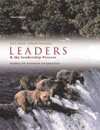 |  Leaders & the Leadership Process: Readings, Self-Assessments, & Applications, 3/e Jon L. Pierce,
University of Minnesota-Duluth
John W. Newstrom,
University of Minnesota-Duluth
Table of ContentsPrologue Self-Assessment: Self-Confidence Reading 1 Perspective on Leadership from Homer’s Odyssey. F. Kramer Part I: Readings Chapter 1: Introduction to Leadership Reading 2 On the Meaning of Leadership, J.L. Pierce and J.W. Newstrom Reading 3 A Study of the Leadership Process, A..J. Murphy Chapter 2: The Leader-Follower Relationship: Fairness, Trust, and Ethics Reading 4 Contemporary Trends in the Analysis of the Leadership Process, E.P. Hollander and J.W. Julian Reading 5 Leadership: The Management of Meaning, L. Smircich and G. Morgan Reading 6 Rethinking the Leader-Member Exchange: An Organizational Justice Perspective, T.A. Scandura Reading 7 Trust in Leadership and Team Performance, K.T. Dirks Reading 8 Leadership, Moral Development, and Citizenship Behavior, J.W. Graham Chapter 3: Leaders and the Role of Personal Traits Self Assessment: Positive and Negative Affect Self-Assessment: Leadership Motivation Reading 9 Personal Factors Associated with Leadership: A Survey of the Literature, R.M. Stogdill Reading 10 Leadership: Do Traits Matter? S.A. Kirkpatrick and E.A. Locks Reading 11 Emotions and Leadership: The Role of Emotional Intelligence, J.M. George Chapter 4: Leadership and the Role of Gender Self-Assessment: Masculinity/Femininity Reading 12 Effects of Sex and Gender Role on Leader Emergence, R. L. Kent and S.E. Moss Reading 13 Gender and Leadership Style: A Meta-Analysis, E.H. Eagly and B.T. Johnson Chapter 5: Leader Emergence Self-Assessment: Self-Monitoring Reading 14 Emergent Leadership and Social Influence, E.P. Hollander Reading 15 Who Gets Power – And How They Hold on to It, G.R. Salancik and J. Pfeffer Reading 16 The Role of Self-Monitoring and Gender on Leader Emergence: A Laboratory and Field Study, G.H. Dobbins, W.S. Long, E.J. Dedrick, and T.C. Clemons Chapter 6: Leadership as an Influence Process Self-Assessment: Influence Tactic Self-Assessment: Personal Power Profile Reading 17 The Bases of Social Power, J.R.P. French, Jr. and B. Raven Reading 18 Consequences of Influence Tactics Used with Subordinates, Peers and the Boss, G. Yukl and J. B. Tracey Chapter 7: Leadership and Leader Behaviors Self-Assessment: Leadership – Michigan Organizational Assessment Self-Assessment: Initiating Structure and Consideration Reading 19 Predicting Organizational Effectiveness with a Four-Factor Theory of leadership, D.G. Bowers and S.E. Seashore Reading 20 Patterns of Leadership Behavior Related to Employee Grievances and Turnover, E.A. Fleishman and E.F. Harris Reading 21 Effects of Leader Warmth and Directiveness on Subordinate Performance on a Subsequent Task, D. Tjosvold Chapter 8: Leadership and Situational Differences Self-Assessment: Least Preferred Co-Worker Reading 22 Path-Goal Theory of Leadership, R. J. House and T. R. Mitchell Reading 23 How Do You Make Leaders More Effective: New Answers to an Old Puzzle, F. E. Fiedler Reading 24 Situational Leadership, P. Hersey Reading 25 A Multidirectional Approach Toward Leadership: An Extension of the Concept of Behavioral Complexity, R. Hooijberg Chapter 9: Leadership in the Cross-Cultural Context Self-Assessment: Individualism- Collectivism Reading 26 Cultural Constraints in Management Theories, G. Hofstede Reading 27 Leadership in Western and Asian Countries: Commonalties and Differences in Effective Leadership Processes Across Cultures, P.W. Dorfman, J.P. Howell, S. Hibino, J.K. Lee, U. Tate, and A. Bautista Chapter 10: Followers and The Leadership Process Reading 28 The Reciprocal Nature of Influence Between Leader and Subordinate, C.N. Greene Reading 29 The Follower’s Role in Leadership Phenomena, F.H. Sanford Reading 30 Leadership, Followership, Self, and Others, E.P. Hollander Chapter 11: Participative Leadership Self-Assessment: Participatory Leadership Attitudes Reading 31 Supervisory Style and Productivity: Review and Theory, S. M. Sales Reading 32 Leadership and the Decision-Making Process, V.H. Vroom Reading 33 Participation, Satisfaction, and Productivity: A Meta-Analytic Review, K.K. Miller and P.R. Monge Chapter 12: Leadership: Substitutes, Neutralizers, and Enhancers Self-Assessment: Substitutes for Leadership Self-Assessment: Group Cohesiveness Self-Assessment: Organization-Based Self-Esteem Reading 34 Substitutes for Leadership: Their Meaning and Measurement, S. Kerr and J.M. Jermier Reading 35 Substitutes for Leadership: Effective Alternatives to Ineffective Leadership, J.P. Howell, D.E. Brwen, P.W. Dorfman, S. Kerr and P.M. Podsakoff Chapter 13: Charismatic and Transformational Leadership Self-Assessment: Transformational and Charismatic Leadership Reading 36 A 1976 Theory of Charismatic Leadership, R. J. House Reading 37 Toward a Behavioral Theory of Charismatic Leadership, J. A. Conger and R.N. Kanungo Reading 38 The Motivational Effects of Charismatic Leadership: A Self-Concept Based Theory, Shamir, House and Arthur Reading 39 Relationship of Transformational and Transactional Leadership with Employee Influencing Strategies, R.J. Deluga Reading 40 Transformational Leader Behaviors and Their Effects on Followers’ Trust in Leader, Satisfaction, and Organizational Citizenship Behaviors, P.M. Podsakoff, S. B. MacKenzie, R. H. Moorman, and R. Fetter. Chapter 14: Dysfunctional Aspects of Leadership Self-Assessment: Machiavellianism Reading 41 The Dark Side of Leadership, J.A. Conger Reading 42 Narcissism and Leadership: An Object Relations Perspective, M.F. R. Kets de Vries and D. Miller. Chapter 15: Does Leadership Really Make a Difference? Point: Leadership is but a Mirage: It Really Does Not Make a Difference Counterpoint: Leadership Really Does Make a Difference Reading 43 The Ambiguity of Leadership, J. Pfeffer Reading 44 Executive Leadership and Organizational Performance: Suggestions for a New Theory and Methodology, D.V. Day and R. G. Lord. Part II Beyond Theory and Into the Practice of Leadership Applications: Case Studies and Experiential Exercises Sam Perkins
A Different Style of Leadership
Donny is My Leader
What You See is (Not Necessarily) What You Get
Tinkertoy Construction
Choosing a Leader
Characteristics of Superior Leaders
Leader-Subordinate Friendships (LSFs)
Leadership (Locker-Room) Talks
Follow the Leader
Leadership Through Film: Power and Influence |
|




 2003 McGraw-Hill Higher Education
2003 McGraw-Hill Higher Education